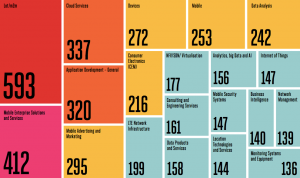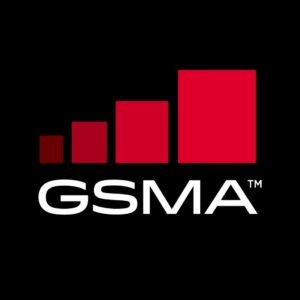Innovation Heat Map Trends
By Osaze Obazuaye, Future Networks, GSMA
Cost reduction is at the forefront of Network Economics; therefore, it is important to identify the innovators who can demonstrate these savings, primarily in infrastructure sharing, backhaul relief and energy efficiency. An initial view of innovation priorities for the industry can be gathered from companies showcasing at Mobile World Congress exhibition events. Looking at all these companies, an Innovation Heat Map has been developed to provide a high-level view of priorities and trends, based on the ‘tags’ associated with each organisation.

The above Innovation Heat Map illustrates the concentration of companies who specialise in various technological services, mainly network related. Companies included have previously attended MWC events, with the information being collated from the GSMA’s MWC exhibition catalogue, filtered by the different product categories, giving an anonymous, aggregated overview of the companies showing at MWC. The Future Networks Programme intend to track these categories over time, to understand how focus and priorities shift over the next few years.
The majority of the trends within the innovation heat map, focus on data from predominately network-related topics. This includes categories such as LTE Network Infrastructure, NFV/SDN/Virtualisation, and Backhaul Solutions. Data used to create the graphic has been extracted from the most recent and largest Mobile World Congress events, MWC Barcelona 2018 and MWC Shanghai 2018.
The biggest bucket within the Innovation Heat Map consists of firms which specialise in providing IoT/M2M operations or solutions. The most significant increase we have seen year-on-year came from the NFV/SDN/Virtualisation field, showing a spike in the number of companies specialising in these services attending MWC events. In contrast, the rest of the top 10 categories showed minimal movement in the types of companies specialising in network related services who attend these events. Though there was minimal movement, there were slight increases in network related tags suggesting more engagement is being made with network related companies.
A key question is why the main network economic categories; energy efficiency, backhaul relief and infrastructure sharing do not appear within this innovation map. This may be attributed to the fact that MWC events focus on new revenue opportunities and not cost reduction, however, with the rollout of 5G we expect to see this trend shift, particularly in energy efficiency.
Companies added to the innovation heat map are shortlisted for programme consideration for case studies. If you would like to be included please complete the submission form here.

